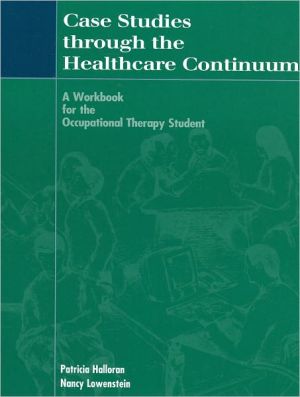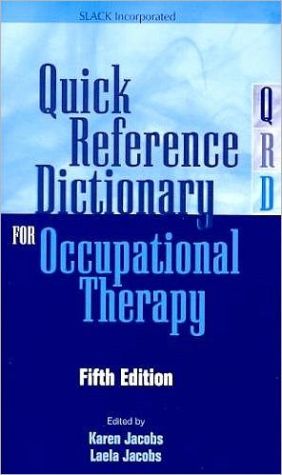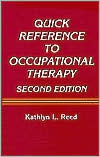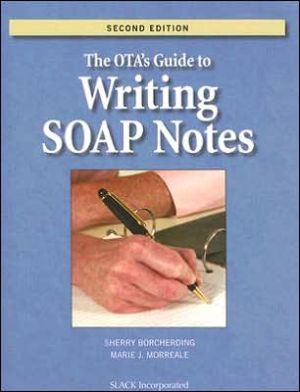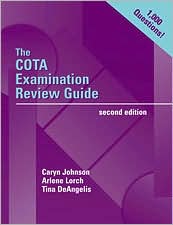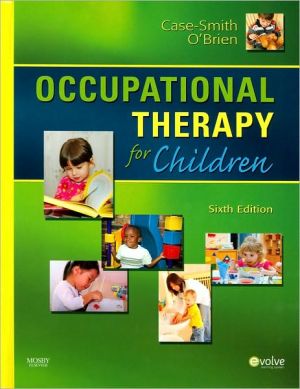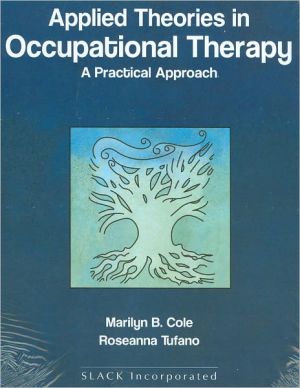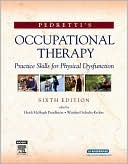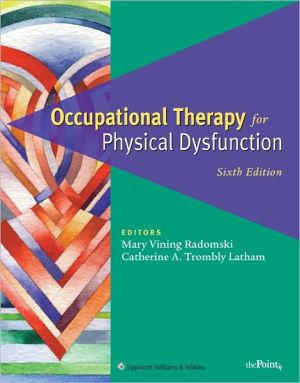Case Studies Through the Healthcare Continuum: A Workbook for the Occupational Therapy Student
This phenomenal new text focuses on assisting students in learning tha t there can be many possible choices in the clinical decision making p rocess, and that these different choices can lead to many equally succ essful outcomes. Case Studies Through the Health Care Continuum: A Wo rkbook for the Occupational Therapy Student is an entire book of case studies of adults with physical and psychological deficits. Each case study is followed by questions, organized around performance areas and...
Search in google:
This phenomenal new text focuses on assisting students in learning that there can be many possible choices in the clinical decision making process, and that these different choices can lead to many equally successful outcomes. Case Studies Through the Health Care Continuum: A Workbook for the Occupational Therapy Student is an entire book of case studies of adults with physical and psychological deficits. Each case study is followed by questions, organized around performance areas and performance components, treatment planning and discharge planning areas. The questions are designed to encourage clinical thinking about the cases. The cases encompass a variety of diagnoses and take place in a variety of health care arenas. By using case studies, students will begin to, and advance, their thinking process before directly dealing with clients. The cases are comprehensive and well thought out, and the questions provide a good starting point for processing and guiding critical thinking. This exceptional text can be used in almost every course in the curriculum! Tiffany Boggis This soft-cover workbook is a collection of 30 case studies of adults with physical and psychological conditions, organized into nine parts according to healthcare setting. Authored by two occupational therapy educators, the purpose is to assist student learning and promote critical thinking such that there may be possible choices in the clinical-decision making process, to better prepare students for clinical fieldwork experiences. With the guidance of an educational instructor, the book is designed for use with students of occupational therapy. Cases may be analyzed individually or in small groups such that case results may be compared to illustrate differences in approaches that lead to effective outcomes. The authors suggest that classes in both professional and technical programs could work on the same case to demonstrate how the OTR/COTA relationship works. Each case contains information about a client's physical, emotional, cultural, and interpersonal attributes. Evaluation results from case histories and occupational therapy assessments are given. This information is the basis for a guideline for the student to progress through the ensuing questions on goals, treatment planning, and discharge planning. Each response affects the answer to the following questions. Impacting issues related to safety/precautions, self-care/work/leisure, equipment/adaptations, patient/family education, and neuromuscular, cognitive/perceptual, and psychosocial components are covered in the questions. This workbook fills a niche since most case studies in current texts address only treatment planning and goal-setting, and do not account for the real-life situations that practicing therapistsencounter once treatment is initiated. The authors present the cases to press the student to integrate and apply knowledge across curriculum course content and facilitate a reduction in the tendency for students to attempt to derive "the one right course of action." The cases may be easily adapted by the creative instructor to focus or redirect case discussions. The questions posed at the end of each case provide rich thought for discussion. A recommendation for a future edition may be to include cases that address the life-span continuum, including conditions and settings common to children and adolescents.
DedicationAcknowledgmentsPt. IIntroduction1Pt. IIAcute Care Hospital3Ch. 1Adam: Myocardial Infarct, Coronary Artery Disease5Ch. 2Beth: Radical Right Mastectomy, Right Upper Extremity Lymphedema13Ch. 3Craig: Spinal Cord Injury at C-5, Complete19Ch. 4Donald: Traumatic Brain Injury - Ranchos Level II27Ch. 5Ellen: Right Total Shoulder Replacement, Rheumatoid Arthritis33Pt. IIIRehabilitation Hospital39Ch. 6Frank: Right Cerebrovascular Accident, Left Hemiplegia, Left Neglect41Ch. 7Gloria: Superficial, Partial- and Full-Thickness Burns, 39% Total Body Surface Area51Ch. 8Harris: Spinal Cord Injury at T3, Complete59Ch. 9Ingrid: Traumatic Brain Injury - Ranchos Level V67Ch. 10Jing: Right Above Elbow Amputation75Pt. IVTransitional Care Unit83Ch. 11Kim: Coronary Artery Bypass Graft x3, Congestive Heart Failure85Ch. 12Lyle: Right Total Knee Replacement93Ch. 13Mary: Left Total Hip Replacement, Osteoarthritis101Ch. 14Nellie: Compression Fractures T12-L2109Ch. 15Oscar: Pneumonia, Chronic Obstructive Pulmonary Disease117Pt. VSkilled Nursing Facility125Ch. 16Paula: Parkinson's Disease127Ch. 17Quinn: Dementia135Ch. 18Rob: Blindness, Insulin-Dependent Diabetes Mellitus143Ch. 19Sean: Left Above Knee Amputation, Stage II Sacral Decubitus Ulcer151Ch. 20Teresa: End-Stage Alzheimer's Disease159Pt. VIOutpatient Rehabilitation Clinic165Ch. 21Ursula: Right Carpal Tunnel Repair, Left Carpal Tunnel Syndrome167Ch. 22Violet: Right Flexor Tendon Laceration, Depression175Ch. 23Walter: Right 2-5 Digit Amputation183Ch. 24Xavier: Bilateral Tendonitis189Ch. 25Yolanda: Left Fractured Humerus, 2 Weeks Post-Injury195Pt. VIIHome and Community Healthcare201Ch. 26Zoe: Rheumatoid Arthritis, Obsessive-Compulsive Disorder203Ch. 27Alice: Multiple Sclerosis213Ch. 28Barb: Left Cerebrovascular Accident, Right Hemiparesis, Expressive Aphasia223Ch. 29Charles: Chronic Obstructive Pulmonary Disease233Ch. 30Dimitre: Right Fractured Radius and Ulna, 6 Weeks Post-Injury241Pt. VIIIInpatient Psychiatric Hospital249Ch. 31Elizabeth: Major Depression, Suicide Attempt251Ch. 32Freddie: Schizophrenia, Paranoid Type with Acute Psychosis257Ch. 33George: Bipolar Disorder, Manic Episode263Ch. 34Harold: Poly-Substance Abuse271Ch. 35Irene: Post-Traumatic Stress Disorder277Pt. IXPsychiatric Day Hospital283Ch. 36Jayna: Borderline Personality Disorder285Ch. 37Kara: Anorexia Nervosa291Ch. 38Leo: Schizoaffective Disorder, Depressive Type297Ch. 39Maura: AIDS-Related Dementia305Ch. 40Nancy: Depression311Index317
\ From The CriticsReviewer: Tiffany L Boggis, MBA, OTR/L (Pacific University)\ Description: This soft-cover workbook is a collection of 30 case studies of adults with physical and psychological conditions, organized into nine parts according to healthcare setting.\ Purpose: Authored by two occupational therapy educators, the purpose is to assist student learning and promote critical thinking such that there may be possible choices in the clinical-decision making process, to better prepare students for clinical fieldwork experiences.\ Audience: With the guidance of an educational instructor, the book is designed for use with students of occupational therapy. Cases may be analyzed individually or in small groups such that case results may be compared to illustrate differences in approaches that lead to effective outcomes. The authors suggest that classes in both professional and technical programs could work on the same case to demonstrate how the OTR/COTA relationship works.\ Features: Each case contains information about a client's physical, emotional, cultural, and interpersonal attributes. Evaluation results from case histories and occupational therapy assessments are given. This information is the basis for a guideline for the student to progress through the ensuing questions on goals, treatment planning, and discharge planning. Each response affects the answer to the following questions. Impacting issues related to safety/precautions, self-care/work/leisure, equipment/adaptations, patient/family education, and neuromuscular, cognitive/perceptual, and psychosocial components are covered in the questions.\ Assessment: This workbook fills a niche since most case studies in current texts address only treatment planning and goal-setting, and do not account for the real-life situations that practicing therapists encounter once treatment is initiated. The authors present the cases to press the student to integrate and apply knowledge across curriculum course content and facilitate a reduction in the tendency for students to attempt to derive "the one right course of action." The cases may be easily adapted by the creative instructor to focus or redirect case discussions. The questions posed at the end of each case provide rich thought for discussion. A recommendation for a future edition may be to include cases that address the life-span continuum, including conditions and settings common to children and adolescents.\ \ \ \ \ From the Publisher"The authors present the cases to press the student to integrate and apply knowledge across curriculum course content...The questions posed at the end of each case provide rich thought for discussion." — Tiffany Boggis, MBA,OTR/L, Doody Publishing\ \ \ \ From The CriticsReviewer: Tiffany L Boggis, MBA, OTR/L (Pacific University) \ Description: This soft-cover workbook is a collection of 30 case studies of adults with physical and psychological conditions, organized into nine parts according to healthcare setting.\ Purpose: Authored by two occupational therapy educators, the purpose is to assist student learning and promote critical thinking such that there may be possible choices in the clinical-decision making process, to better prepare students for clinical fieldwork experiences.\ Audience: With the guidance of an educational instructor, the book is designed for use with students of occupational therapy. Cases may be analyzed individually or in small groups such that case results may be compared to illustrate differences in approaches that lead to effective outcomes. The authors suggest that classes in both professional and technical programs could work on the same case to demonstrate how the OTR/COTA relationship works.\ Features: Each case contains information about a client's physical, emotional, cultural, and interpersonal attributes. Evaluation results from case histories and occupational therapy assessments are given. This information is the basis for a guideline for the student to progress through the ensuing questions on goals, treatment planning, and discharge planning. Each response affects the answer to the following questions. Impacting issues related to safety/precautions, self-care/work/leisure, equipment/adaptations, patient/family education, and neuromuscular, cognitive/perceptual, and psychosocial components are covered in the questions.\ Assessment: This workbook fills a niche since most case studies in current texts address only treatment planning and goal-setting, and do not account for the real-life situations that practicing therapists encounter once treatment is initiated. The authors present the cases to press the student to integrate and apply knowledge across curriculum course content and facilitate a reduction in the tendency for students to attempt to derive "the one right course of action." The cases may be easily adapted by the creative instructor to focus or redirect case discussions. The questions posed at the end of each case provide rich thought for discussion. A recommendation for a future edition may be to include cases that address the life-span continuum, including conditions and settings common to children and adolescents.\ \ \ \ \ Tiffany BoggisThis soft-cover workbook is a collection of 30 case studies of adults with physical and psychological conditions, organized into nine parts according to healthcare setting. Authored by two occupational therapy educators, the purpose is to assist student learning and promote critical thinking such that there may be possible choices in the clinical-decision making process, to better prepare students for clinical fieldwork experiences. With the guidance of an educational instructor, the book is designed for use with students of occupational therapy. Cases may be analyzed individually or in small groups such that case results may be compared to illustrate differences in approaches that lead to effective outcomes. The authors suggest that classes in both professional and technical programs could work on the same case to demonstrate how the OTR/COTA relationship works. Each case contains information about a client's physical, emotional, cultural, and interpersonal attributes. Evaluation results from case histories and occupational therapy assessments are given. This information is the basis for a guideline for the student to progress through the ensuing questions on goals, treatment planning, and discharge planning. Each response affects the answer to the following questions. Impacting issues related to safety/precautions, self-care/work/leisure, equipment/adaptations, patient/family education, and neuromuscular, cognitive/perceptual, and psychosocial components are covered in the questions. This workbook fills a niche since most case studies in current texts address only treatment planning and goal-setting, and do not account for the real-life situations that practicing therapistsencounter once treatment is initiated. The authors present the cases to press the student to integrate and apply knowledge across curriculum course content and facilitate a reduction in the tendency for students to attempt to derive "the one right course of action." The cases may be easily adapted by the creative instructor to focus or redirect case discussions. The questions posed at the end of each case provide rich thought for discussion. A recommendation for a future edition may be to include cases that address the life-span continuum, including conditions and settings common to children and adolescents.\ \ \ \ \ BooknewsPresents case studies of adults with physical and psychological deficits, each followed by questions organized around performance components, treatment planning, and discharge planning areas. The cases encompass a variety of diagnoses, such as spinal cord injury, AIDS-related dementia, and congestive heart failure, and take place in a variety of healthcare arenas, such as acute care, psychiatric, and rehabilitation hospitals, skilled nursing facilities, and home and community health care. This is a workbook designed to encourage students' clinical reasoning skills, and is not intended to teach theories and constructs for clinical reasoning. The authors are instructors and practicing therapists. Annotation c. Book News, Inc., Portland, OR (booknews.com)\ \ \ \ \ 4 Stars! from Doody\ \
